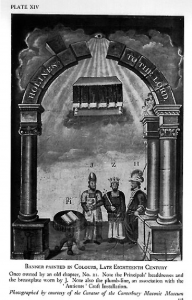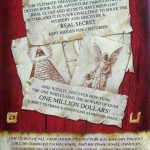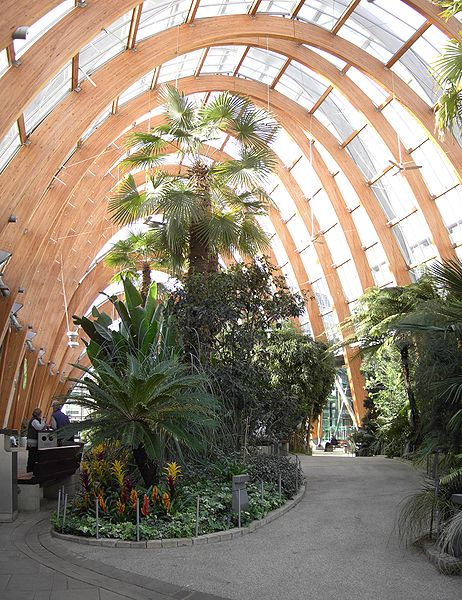![462px-Sheffield_Winter_Garden[1]](https://mysteriouswritings.com/wp-content/uploads/2012/06/462px-Sheffield_Winter_Garden1-231x300.jpg) In the late 17th century, the discovery for creating the strongest form of arch was realized. Robert Hooke had stated he found “the true mathematical and mechanical form of all manner of arches for building.” Initially encoded by means similar to that of an anagram (abcccddeeeeefggiiiiiiii-ilmmmmnnnnnooprrsssttttttuuuuuuuux), Hooke’s studies would later be revealed and applied. His string of letters, when re-arranged, held the details; “As hangs a flexible cable, so inverted, stand the touching pieces of an arch” (Ut pendet continuum flexile, sic stabit contiguum rigidum inversum). From this, the catenarian arch was expressed.
In the late 17th century, the discovery for creating the strongest form of arch was realized. Robert Hooke had stated he found “the true mathematical and mechanical form of all manner of arches for building.” Initially encoded by means similar to that of an anagram (abcccddeeeeefggiiiiiiii-ilmmmmnnnnnooprrsssttttttuuuuuuuux), Hooke’s studies would later be revealed and applied. His string of letters, when re-arranged, held the details; “As hangs a flexible cable, so inverted, stand the touching pieces of an arch” (Ut pendet continuum flexile, sic stabit contiguum rigidum inversum). From this, the catenarian arch was expressed.
Deriving from the Latin word, catena, for chain, catenary is the curve generated by allowing a chain to hang freely between two points. This curve displays the perfect shape for constructing an arch. Hooke realized the arc, which fell below set points, was like a mirror image for forming a structure above. It offered builders the sacred pattern for a catenary arch.
Many different types of arches are known and some date back thousands of years. They are curved constructions which span openings and support the overlying material. Using wedge shaped stones, called voussoirs, a craftsman raises an arch. Although all elements of an arch work together, the keystone provides the final balance and is usually the last to be placed. The opposing forces from the downward load to the upward thrust are in perfect equilibrium once the centrally located keystone (often called the crown) is set. The catenarian arch is considered the strongest arch because it is perfectly balanced while all pressures are being carried to the foundation.
According to Mackey’s encyclopedia of freemasonry, Royal Arch Masonry is known to employ the catenarian arch. And in The Freemason’s Book of the Royal Arch, a reference is made to the importance of the Keystone and the Royal Arch chapter. The keystone is said to be called the cope stone; the stone which ‘finishes the work.’ (This phrase possibly relates to Manly P. Hall’s statement referred to in the post of The Missing Capstone). The understanding is then applied to the statement, ‘The Royal Arch is the cope-stone of the Masonic Order.’
Also in The Freemason’s Book of the Royal Arch, the following paragraph is found:
 “Many tracing boards and particularly jewels of the eighteenth century depict the arch with the centre stone removed, and in a great many cases the arch is not a single construction. Often it consists of three..”
“Many tracing boards and particularly jewels of the eighteenth century depict the arch with the centre stone removed, and in a great many cases the arch is not a single construction. Often it consists of three..”
This calls to mind the Time Monk article written by Duncan Burden which referred to lost secrets of freemasonry. One of the most widely known legends of freemasonry is the search for the lost Word. Perhaps this keystone missing from the arch represents the lost Word to be found? This may be supported by a previous thought in the above mentioned book. A suggestion was made which said that since ‘arche’ is Greek for ‘beginning’, the popular Biblical verse, “In the beginning was the Word”, could be read as “in the arch was the Word.”
This also brings the Marantha puzzle into consideration. It encouraged puzzlers to search for a Word. The search for the Lost Word can be pursued by anyone. A person does not have to belong to the official Masonic orders to seek this wisdom; for everyone is a mason; a builder of the self. Perhaps the Word is representative of the perfect balance which is found by placing the keystone; a stone which binds and balances all opposing forces together.
If one wanted to be more inquisitive, one could consider the chain seen on the image of the supposed bookplate of Berenger Sauniere. Even though this bookplate has never been confirmed to actually be Sauniere’s, it was chosen by someone for a reason. It has also been depicted on the back cover of the Time Monk version of the Maranatha puzzle. The book claimed the powerful secret found within was also that of Rennes le Chateau’s.
 Perhaps the chain in the image is symbolic of the catenary; an arc with connection to the above and below. It may be a reminder of God’s covenant; the arc of the rainbow. Genesis 9:15 states; “I will remember my covenant between me and you and all living creatures of every kind.” Seen held in the hands of the Angel, the chain dangles above the kneeling demon. It symbolically rests between the angel and beast, demonstrating an arc between the above (God) and below (Man).
Perhaps the chain in the image is symbolic of the catenary; an arc with connection to the above and below. It may be a reminder of God’s covenant; the arc of the rainbow. Genesis 9:15 states; “I will remember my covenant between me and you and all living creatures of every kind.” Seen held in the hands of the Angel, the chain dangles above the kneeling demon. It symbolically rests between the angel and beast, demonstrating an arc between the above (God) and below (Man).
Speculation on meaning will persist. Many readers continue to contemplate the Maranatha puzzle; looking for the secret which may also shed light on the mystery of Rennes le Chateau.
Sources:
Masonic Dictionary, Catenarian Arch, reviewed May 2012
Robert Hooke, Law of the Arch, Linda Hall Library, reviewed May 2012
Freemason’s Book of the Royal Arch, reviewed May 2012


I thought the chain on the ‘Sauniere’ book plate, in conjuction with the folds on Raphael’s tunic, formed a Tau.
I don’t recall seeing a defined arch as such.
Horatio, the Tau definitely does take center stage in the image. Even though the arc is ever so slight in the chain, all elements are there for a catenary. Since the chain does form the top and one side of the T, it is almost like they are meant to be understood together.
And Hayward (in response to below comment), I see I need to learn more about ships. Wonderful thoughts. Thank you for them.
Thank you for a very thought-provoking piece. I have often pondered the relationship between the Arch and the Ark used in various sources of historic significance. The term Arch being used for an overhead support structure and the Ark referring to a ship or a vessel. Is not the ridge and the profile of ship’s hull also an Arch, but inverted?
Really Nice Article! I am beginning to Feel this deeper sense of respect for what was printed on the Dollar Bill.
I think Hooke’s anagram was meant to drive home the point that you can’t unscramble an anagram of more than around 10 letters unless you have some specific method to unscramble it, simply because there are too many valid sentences (hundreds, perhaps thousands) that it could anagram into, and there is no way of knowing which one was intended without more information.
This was a very interesting read, and thanks for the wonderful website!
The arch design by ‘inverted hanging cables’ can be visualized in the museum beneath the Sagrada Familia in Barcelona.
Gaudi did a lot of his design by this method and it is an amazing thing to view his work.
Here is a link to a picture of one of the displays: http://images.oobject.com/thumbdir/thumbnails/3/21/321da867cbfa86c90cf613c1a190c0e0-orig